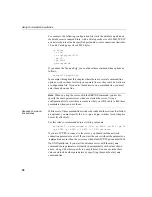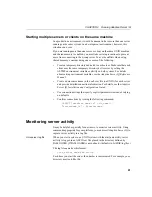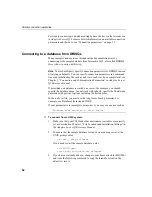
Using command-line switches
40
Setting the default
client timeout
Adaptive Server IQ disconnects client connections that have not submitted a
request for the number of minutes you specify with the
-ti
switch. By
disconnecting inactive connections, this option frees any locks those
connections hold. The default is 240 (4 hours). Raising this to the
recommended value, 4400 (about 73 hours), lets you start long runs at the
beginning of a weekend, for example, and ensure that any interim results will
not be rolled back.
Starting a server in forced recovery mode
Should you need to restart your server after a failure, you can usually do so
using the same startup options as usual.
On rare occasions, you may need to supply startup options to force recovery or
to recover leaked storage. To start the server with these options, see the chapter
“System Recovery and Database Repair” in the Adaptive Server IQ
Troubleshooting and Error Messages Guide.
Starting a server from DBISQL
If you are already connected to a running database server, you can start a new
server from DBISQL. Use the
START ENGINE
command to start a named
server from DBISQL.
Note
This method is not recommended for most situations. If you use it be sure
you are starting the server on the system you intend, that you include
appropriate server parameters in the
STARTLINE
, and that environment
variables are set appropriately on the system where the server will start.
Example
The following DBISQL command, entered on one line, starts a database server,
names it
jill_newserv
, and specifies the network connection, number of
connections, and Catalog page size.
START ENGINE AS jill_newserv
STARTLINE ’asiqsrv12 -x tcpip(port=5678) -gm 10 -gp
4096’
Summary of Contents for Adaptive Server IQ 12.4.2
Page 1: ...Administration and Performance Guide Adaptive Server IQ 12 4 2 ...
Page 16: ...xvi ...
Page 20: ...Related documents xx ...
Page 40: ...Compatibility with earlier versions 20 ...
Page 118: ...Troubleshooting startup shutdown and connections 98 ...
Page 248: ...Importing data by replication 228 ...
Page 306: ...Integrity rules in the system tables 286 ...
Page 334: ...Cursors in transactions 314 ...
Page 396: ...Users and permissions in the system tables 376 ...
Page 438: ...Determining your data backup and recovery strategy 418 ...
Page 484: ...Network performance 464 ...
Page 500: ...System utilities to monitor CPU use 480 ...
Page 514: ...Characteristics of Open Client and jConnect connections 494 ...
Page 536: ...Index 516 ...
















































